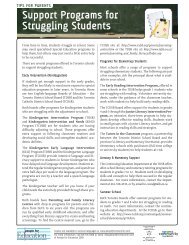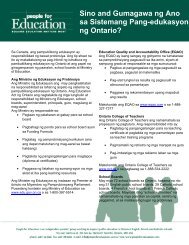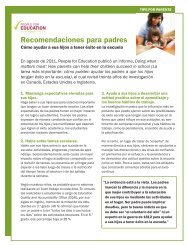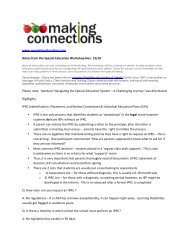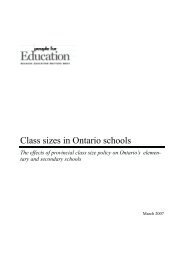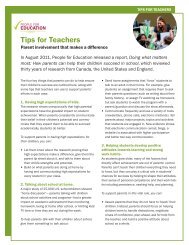Our Children Our Future Our Vision - People for Education
Our Children Our Future Our Vision - People for Education
Our Children Our Future Our Vision - People for Education
You also want an ePaper? Increase the reach of your titles
YUMPU automatically turns print PDFs into web optimized ePapers that Google loves.
<strong>Our</strong> <strong>Children</strong>, <strong>Our</strong> <strong>Future</strong>, <strong>Our</strong> <strong>Vision</strong><br />
schools were based if they continue to allow First Nations children to receive a substandard education.<br />
211 Yet, scholars, researchers and economists recognize that although immediate needs will<br />
have a high initial cost, those re<strong>for</strong>ms will save money in the long term. 212<br />
The issue relates more to adequacy than equity. Adequacy relates to the actual amount of funding<br />
needed to achieve pre-identified goals whereas equity is limited to the total resources Canada<br />
claims are available. 213<br />
Those who consider equality of education to mean equality of funding<br />
make an assumption that all students are on the same playing<br />
field. Thus, due to the educational gap that exists in Canadian society,<br />
the emphasis should not be placed on the equality of educational<br />
opportunity, rather, in the interest of closing the gap the focus<br />
should be on equalizing educational outcomes. 214<br />
Thus, true equality <strong>for</strong> First Nations education not only means funding education at levels which<br />
are no less than provincial levels, but also additional funding to help address the current educational<br />
gap created by federal laws and policies over many generations. Canada created this mess;<br />
it needs to support First Nations to fix it. The success of First Nations peoples in education should<br />
be of “vital interest” to all Canadians as the country’s social and economic prosperity depends on it. 215<br />
Today, the discriminatory levels of service provided to First Nations are the result of INAC control,<br />
inappropriateness of the Indian Act as vehicle to deliver education; and the lack of financial and<br />
governance support provided to First Nations. 216 Moving <strong>for</strong>ward, there must be a comprehensive<br />
education budget and fully supported infrastructure if we expect First Nations to not only close the<br />
gap, but to excel. 217<br />
Adjustments to the funding <strong>for</strong>mulas <strong>for</strong> First Nation education must be comprehensive, flexible<br />
and stable with a focus on adequacy (First Nation needs and goals) and not equity (a share of predetermined<br />
funding envelopes).<br />
211 Ibid.<br />
212 J. Paquette, “Supporting First Nations secondary students studying away from home: A case history of policy gone<br />
awry” 41:2 (2007) J. of Can. Studies 88.<br />
213 Investing in the <strong>Future</strong>, supra note 175 at 6.<br />
214 <strong>Education</strong>al Cost Drivers, supra note 201 at 7.<br />
215 AFN Fact Sheet, supra note 141.<br />
216 C. Sheila, “First Nations education: Financial Accountability and <strong>Education</strong>al Attainment” (2006) 29:4 Can. J. of Educ.<br />
998-1018 at 1005-1006.<br />
217 <strong>Our</strong> <strong>Children</strong>, supra note 106 at 33.<br />
49 Chiefs of Ontario



